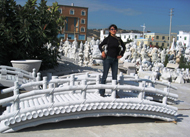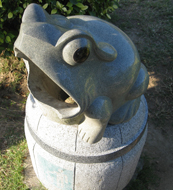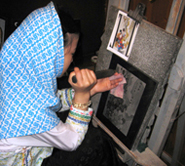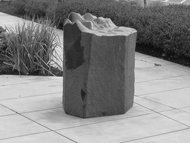A Sculptor's China Odyssey - Jan/Feb 2008
- Details
- Created: Wednesday, 16 December 2009 06:21
To guide sculptors who would wish to have work executed in China, here is an outline of a current project, the problems with local production, the Chinese option and the result.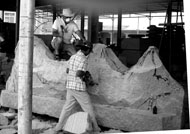
In 2007 I had the good fortune to be awarded my third public art commission for a new edifice in the City of Burnaby, a suburb of Vancouver. The client wanted the work to pay tribute to the reclamation of a local creek - a project undertaken by neighborhood children. Accordingly, I designed a ‘creek’ scenario set into the pavement stones that surrounded the complex, leading to the street-corner focal point. My concept for that focal point was a 12-foot-long granite salmon, frisking on the water and being ridden by two joyous children.
My first problem was finding a stone. I found I couldn’t buy an ‘off-the-shelf’ quarry block that would do the job. The machinery for sawing and handling granite at the mills is all set up for 10 foot blocks.
I therefore set about trying to extract my own block from an abandoned quarry at Squamish, a few miles north of Vancouver. Only to be frustrated, when having spent most of my up-front money on the necessary machinery to get an amply long stone, I found it to have a hidden fault right through the centre. I decided there wasn’t enough money left in the commission price to cover another attempt at acquiring a stone as well as pay me and my yard/studio expenses for the work. In a panic, I turned to Northwest Landscape Supply, the quarry owners, for help. Their recommendation and the series of events that followed made a success out of what began as a disaster.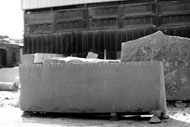
I decided, at the suggestion of Ian Fraser of Northwest Landscape Supply to carve a detailed model and write supporting instructions. Ian sent the model off to ‘his people’ in China, and e-mailed me ten days later with a price, fully carved and finished, laid down at Ian’s yard in Burnaby. The price was about the same as I would pay for the quarry-block alone here. Essentially, the carving would be free.
I had a mental wrestling match with the philosophy of selling to my client a signed artwork that was in fact carved by others, but I could not ignore the economics. Upon reflection, I decided that enough money could be saved for me to beetle off to China and take charge of, and participate, in the carving and hence could make an adventure out of it while satisfying my conscience.
I placed the order. Ian did not ask for a deposit, but introduced me by e-mail to Ellen He, a thoroughly decent young woman who owns an independent manufacturers’ agency (Galaxy Stone) in Xiamen, China. She farms orders similar to mine out to various stone-carving factories, mostly in Fujian Province just to the north of Xiamen. Once in production, she becomes a drill-sergeant, seeing the work through quickly, making sure it is packed properly, arranging transport to North America, and faithfully handling all the money. See her website: www.xmgalaxystone.com/
I talked to Ellen several times on the phone and when she was able to advise me that the work was about to commence, I headed off to China. Ellen met me at the plane and arranged for a beautiful Best Western hotel.
The following day, she and her husband drove me to Hui’an, a city about the size of Bellingham, two hours north of Xiamen. Hui’an has Granite sculptures lining the approaching highway for almost ten miles, huge things, beautifully, artistically carved. In the city are perhaps fifty carving factories where finished sculptures in granite fill their yards like fish in the sea. There is simply nothing like it in North America.
Lodged at a hotel again booked by Ellen, I walked daily to the carving factory Ellen had chosen for me. My block had been cut to gross dimensions when I arrived and the carving started immediately. Like a typical blundering, know-it-all North American, I threw my weight around like I intended to take charge of the place. The team of three carvers assigned to my work politely gave me some tools and I started in to fret off some granite. They stood there politely, mostly looking at their feet. Right away, even my thick head could see that they were wishing I would just piss off and let them get on with it. It seemed a wise thing to do, especially considering the heat. With a polite cough, I indicated that I wished to take pictures of the other sculptures and made myself scarce.
Looking back in on the work every half-hour or so, it became readily apparent that if I knew enough about granite carving to fill a book, they knew enough to fill a bigger one. Their work was calm and measured but fast and certain. It was scary to watch because they would drill and wedge off large chunks between important parts. I have gotten into trouble more than once when my wedging force went haywire, but for them it never failed to break off just right.
I stayed for seven days, looking in on the work each day but staying discreetly away from interfering with their remarkable progress. My instructions to them (and my guiding maquette) were to leave the faces on the children and the braid on the little girl blank. I intended to carve these myself when the sculpture arrived at my own yard. But through Andy Liu, the factory interpreter, they wheedled and whined that they wanted to do this work, please, please, please…. In the end, I agreed, leaving them with more sketches to be certain they would do the work satisfactorily. I then headed home.
In three weeks, the sculpture arrived at the Northwest Landscape yard, safe and sound. Looking at the finished work, I was disappointed in several aspects but abundantly pleased for the overall work that had been done as well as the dispatch with which it had been carried out. The faces and the braid they wanted so badly to carve didn’t work out. My guys were competent granite-carvers to be sure; but they were not artists. The faces, the braid and some other details will require my own hand to make them look like my work. Luckily there is enough stone for corrections.
In summary, I see no reason ever again to go through the energy and money to locally carve any granite sculpture bigger than a breadbox. The thing to do is carve an articulate model from high-density modeling foam, have Ellen He put it in production in China, ship it back here and spend the time in between fishing.
I’ll mention one caveat. It is tempting to deal directly with the factory to save any commissions taken by Northwest Stone and Ellen. However, when any substantial work arrives back home, it must be stickhandled through Customs and physically de-containerized. This is not the kind of thing the average sculptor can do. For that reason, I recommend placing the order with Northwest Stone, who do all this, and they in turn will order the work on Ellen He’s agency. The sculptor can then discuss the work directly with Ellen.
Neither she nor Northwest Stone takes an unreasonable cut. In fact, their commission was included in the original price quoted and without knowing that figure I can tell you that they are worth their pay.
At the time of this writing, December 29, 2007, the 12-ft. salmon with kids is set down in my studio/yard in Vancouver, BC. About a week’s cosmetic work will finish it off. Having the work done in China was a good option for me. Any sculptor in our society who would wish to follow this path is welcome to contact me for whatever guidance I can give.
For more information, go to my website: web.mac.com/granitecarver. Click on the link China Odyssey 3 to read about the remarkable role women play in granite carving production.


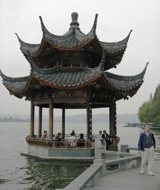
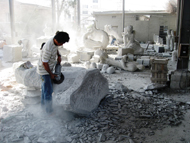
 t of details.
t of details.